#ichneumonid wasps
Text
Uncharismatic Fact of the Day
As every expecting mother knows, finding the perfect place to lay your eggs is of the utmost importance. That's why the long-tailed giant ichneumonid wasp has such a long ovipositor! This special organ is more than twice the wasp's body length, and is used to tunnel deep into decaying wood in order to deposit their egg on the body of their host species the pigeon horntail (Tremex columba).

(Image: A female long-tailed giant ichneumonid wasp (Megarhyssa macrurus) depositing her egg by Richard Orr)
If you like what I do, consider leaving a tip or buying me a ko-fi!
#long-tailed giant ichneumonid wasp#hymenoptera#Ichneumonidae#giant ichneumonid wasps#ichneumonid wasps#wasps#hymenoptrids#insects#arthropods#uncharismatic facts
166 notes
·
View notes
Photo


Parasite wasp pupae.
Charops
18/05/22
#Charops#Campoplegini#Campopleginae#Ichneumonidae#Ichneumonid Wasps#Ichneumonoidea#Apocrita#Hymenoptera#wasps#parasitic wasps#pupae
13 notes
·
View notes
Note
hiya! could I get a bug identification please?
there are at least 6 of these creatures in my bathroom and I need to know if I should be scared, thank you!

I'm in the Mojave desert/California area, and they flew in at night. they're about an inch(?) long (sorry for the blur, I have shaky hands <3)
No need to be scared, they're ichneumonid wasps. Solitary parasitoids that don't sting defensively.
187 notes
·
View notes
Text
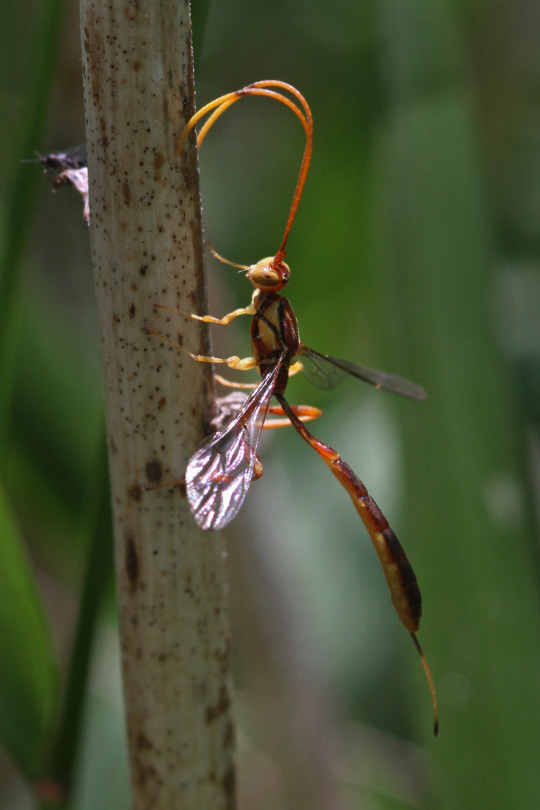

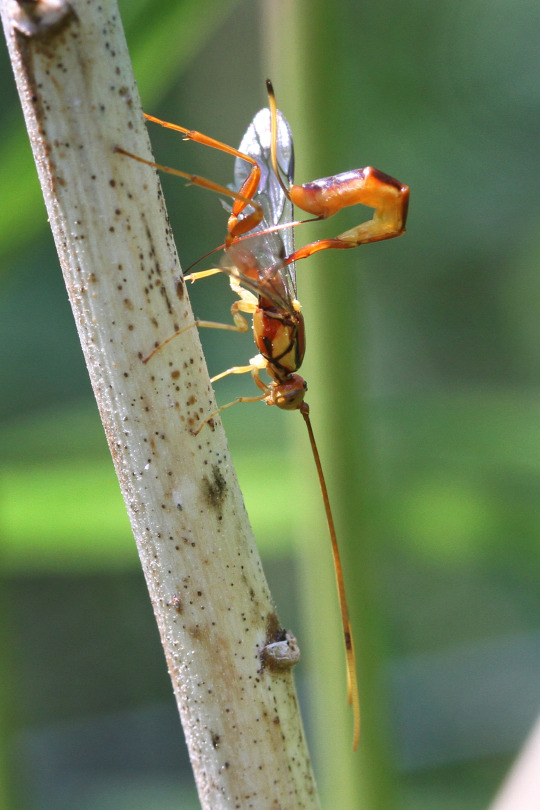
Grotea anguina, a member of the Ichneumonid wasps
June 10, 2023
Southeastern Pennsylvania
#bugs#bug#photographers on tumblr#Grotea anguina#Ichneumonid wasp#wasp#wasps#hymenoptera#bugblr#insects#insect#entomology#nature#animals
345 notes
·
View notes
Text
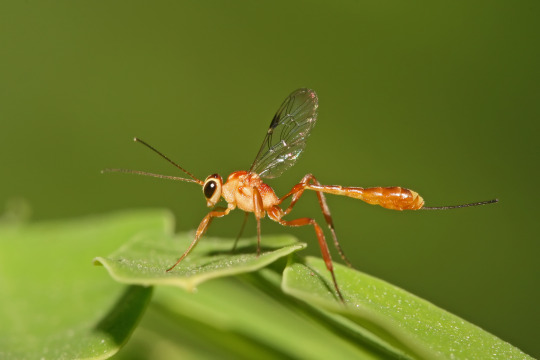
Ichneumonidae of sub family Anomaloninae. The insect was around 5mm long. Pictured in Dar es Salaam.
81 notes
·
View notes
Text
AUUURGGHH I LOVE WASPS!!!!!!! YAAAYYYY <- caught her favorite wasp family today and is ecstatic about it
#It’s ichneumonidae. By the way#clamtalk#bugposting#Look i love obnoxious ovipositors. And ichneumonids? Well fuck man. They have those#I’ve been trying to catch one of these freaks for the past year and every time they just narrowly escaped me#until NOW!!! HAHAHAHAA!!!#I got bitten by a mosquito for my efforts but WHO CARE!!! FUNNY WASP ACQUIRED YAAYYY
21 notes
·
View notes
Text

Ichneumon wasp pollinating an Australian orchid
By: Oxford Scientific Films
From: The Complete Encyclopedia of the Animal World
1980
#ichneumonid#wasp#hymenopteran#insect#arthropod#invertebrate#1980#1980s#Oxford Scientific Films#The Complete Encyclopedia of the Animal World (1980)
55 notes
·
View notes
Text
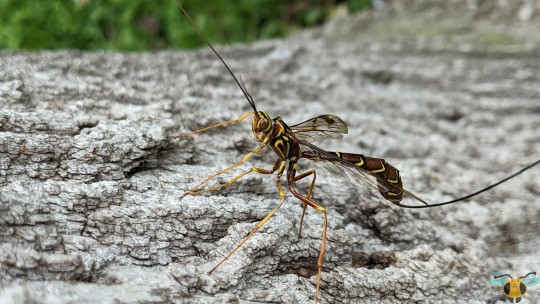


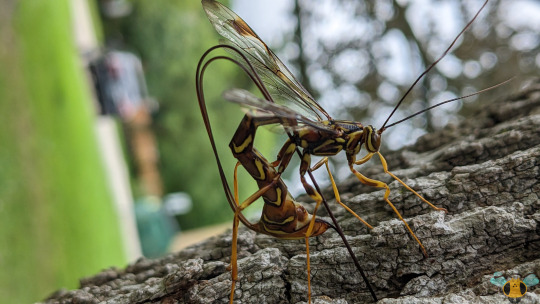
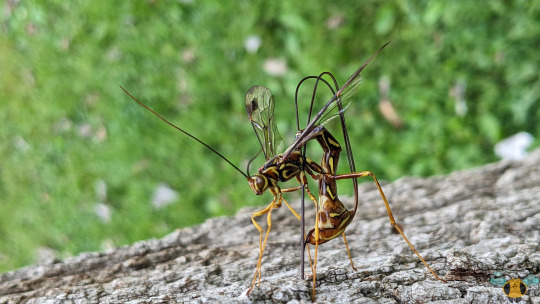




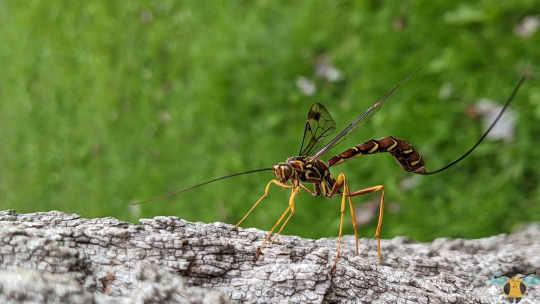
Long-Tailed Giant Ichneumonid Wasp - Megarhyssa macrurus
To anyone wondering why this giant wasn't included in the "Insect Highlights of 2023", it's simply because there were enough pictures taken to allow a second showcase! She's a very impressive creature, and I'm fortunate to have found her last year. I hope to find a few more specimens in the future, especially if they revisit the tree this one was exploring or similar trees in the surrounding area. As a reminder, Giant Ichneumonids like this specimen are drawn to old, decaying trees in search of Pigeon Horntail larvae for their own eggs. Using their elongated ovipositor they pierce through the wood like a syringe, paralyze a developing larva and place an egg on it. This whole process is done without even so much as seeing the larvae hidden in the tree trunk, but they are searched for via scent cues on the bark, listening for sounds via her legs and feeling for them with her sting as it is pressed downward! Though it looks unwieldy, it is surprisingly easy for an Ichneumon Wasp of this size to orient itself to "drill for larvae". When she's decided on a suitable location, she extends her abdomen and legs as far as they will go, orienting her ovipositor to be as vertical as possible! Since the ovipositor is long, it will take a series a fine adjustments to pull it in so that it lines up parallel to the abdomen.
After it is pressed into the tree trunk the ovipositor is fully unsheathed and the Long-Tailed Giant's search proceeds. The individual in these pictures had just begun to drill for larvae (and had re-sheathed upon my return 1 hour later) Although it may seem precarious, it's important to keep in mind that the ovipositor (which can be more than twice the length of the insect’s body) is not a stiff filament. It appears stiff while inside its sheath and carried behind the insect under normal circumstances. In fact, it is somewhat flexible and can be maneuvered around tree-bound obstacles while searching for larvae. The flexibility also offers an easier exit when withdrawing from the hole in the tree, but not a hasty one: should the ovipositor became damaged, the Wasp will not be able to lay eggs, so withdrawal is monitored carefully. If you'd really like to see an unwieldly "stinger", try and observe an Ichneumon flailing the ovipositor around and place it smoothly back inside her sheath! Do not fear when observing this imposing beauty; though the ovipositor is long and prominent, her "stinger" cannot harm a human. As you've read above, her stinging process requires a lot of telegraphing to be effective, and Ichneumonid adults are not predators nor are they interested in humans. Though Wasps, there is a world of difference between Ichneumonids and some of the more common social Wasps of Ontario.
Pictures were taken on August 24, 2023 with a Google Pixel 4.
#jonny’s insect catalogue#ontario insect#wasp#ichneumon wasp#long tailed giant ichneumonid wasp#megarhyssa macrurus#giant ichneumon#hymenoptera#insect#toronto#august2023#2023#nature#entomology#invertebrates
15 notes
·
View notes
Text

yoga
#anthro#bug people#ichneumonid wasp#flameshadowart#warmup sketch after seeing a pic of a wasp cleaning her wings with her hind legs and i called it bug yoga#id in alt
96 notes
·
View notes
Text
Uncharismatic Fact of the Day
Wasps can't build webs-- that's why they get spiders to do it for them. Some ectoparasitoid wasps like Reclinervellus nielseni lay their eggs on unsuspecting Cyclosa orb weaver spiders; once hatched, the larva injects its host with a venom that changes the way it weaves its web! The strands used are thicker, tougher, and glow under ultraviolet light, traits thought to prevent superfluous insects from getting caught. Once the web is complete, the wasp larva eats the spider and uses the web as a base for its cocoon.

(Image: A Reclinervellus nielseni larva attatched to its host, Cyclosa argenteoalba, by Keizo Takasuka)
If you like what I do, consider leaving a tip or buying me a ko-fi!
#Reclinervellus nielseni#hymenoptera#Ichneumonidae#ichneumonid wasps#wasps#hymenoptrids#insects#arthropods#uncharismatic facts
91 notes
·
View notes
Text
i don’t know what to tell you guys. if youare bored simply just go outside at night and look at the bugs that fly near light fixtures for some endless and fun entertainment
#saw a little ichneumonid wasp grooming itself today. splendid#other night i watched a spider wrap a moth in its web and take it behind the siding of my house#it’s like a drama to me#bugs
12 notes
·
View notes
Text


@microecobus submitted: Hello onenicebug, i want to show you this majestic wasp which i found 2 years ago.
Still dont know what this species is. In my region, there is Megarhyssa perlata, but thorax markings coloration are off, so it must be another species
I'd need to know the location to be sure but it looks like a male Megarhyssa perlata. Females have different markings and of course the long ovipositor.
138 notes
·
View notes
Text



bold jumping spider, red-banded leafhopper, and a parasitoid wasp
6 notes
·
View notes
Text

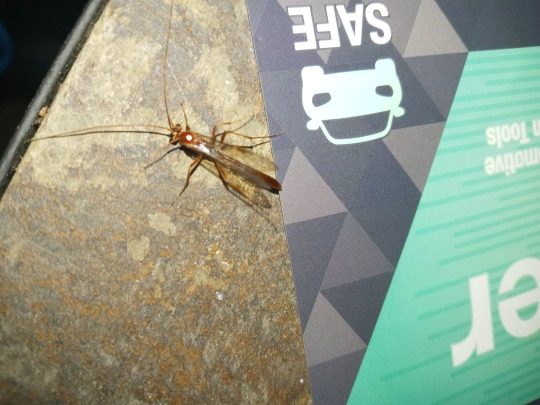

#ichneumonidae#ichneumon wasps#ichneumonid wasp#Wasp#Wasps#Hymenoptera#Insects#Insect#Bugs#Bug#Entomology#Arthropods#Photos#Photo#Wasp House Sights
3 notes
·
View notes
Text





Third and last vid and some more pics of ichneumonid (?) friend! I love watching them clean themselves 😊
2 notes
·
View notes
Text
Megarhyssa macrurus man ooooooh
#gamer txt.#its like. THE ichneumom to me. have you seen this thing#its extremely long gaster and oviposter are just sso. slay#its ovipositor which is also 2 ovipositors and 2 extra filaments btw#the way they curl and twist around is just so.#like go on inat and look at them theyre so funky#like yeah the long tailed giant ichneumonid wasp. it sure fucking is
1 note
·
View note